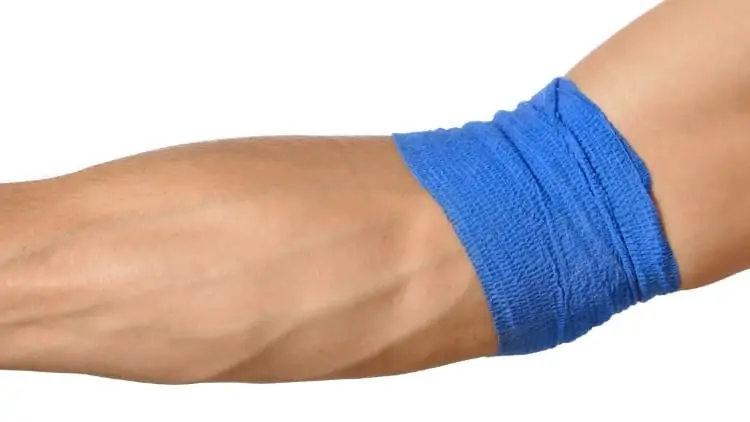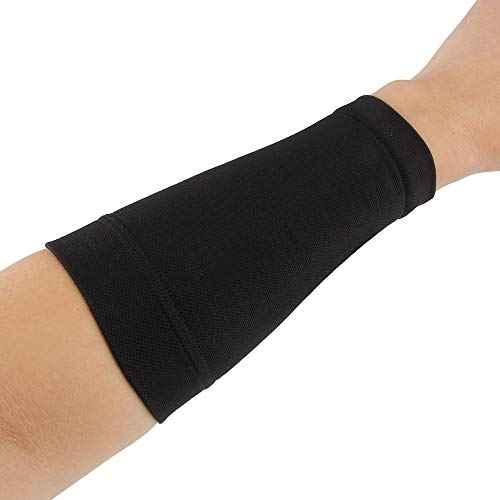The forearm is a highly visible body part and one that we use for so many different tasks. But despite its importance, the forearm is an area that most lifters neglect, for one reason or another.
This is where forearm wraps can come in real handy.
A forearm wrap is most commonly applied to each limb by people who train with kettlebells and who want to prevent their wrists from bruising.
But anyone who works out and wants extra protection for their vulnerable forearm bones can get a lot of mileage out of a forearm compression wrap.
Related posts: forearm splint brace │forearm taping
How can forearm wraps help you?
While forearm wraps aren’t a cure for bad form, it’s nice to have an extra layer of cushion and protection between your lower arms and a great big kettlebell.
Prevents forearm bruising
Kettlebell training is fun. But the resulting wrist damage isn’t. And it’s not like a bruise here or there will inflict significant harm. However, when these minor injuries start to add up, you might find that at some point, even just holding a kettlebell in your hands is too painful.
Therefore, if you’ve experienced bruising from your workouts, investing in a simple forearm wrap sooner rather than later is one of the best preventative measures that you can take against further wrist damage.
Promotes faster muscle recovery
While a quality forearm compression wrap can prevent your arms from getting knocked and bruised, the same wrap can also speed up your recovery via its primary purpose: compression.
This is because when you slightly compress a muscle, you naturally promote better blood flow to damaged connective tissue. Now you know why compression is part of the Rest, Ice, Compression, Elevation (RICE) recovery protocol that’s commonly used to heal sporting injuries.
Just don’t wrap these devices too tight. Otherwise, your forearm will feel like it’s suffocating. A little goes a long way when it comes to muscle compression.
Increases muscle growth
On the other hand, you might actually want to use forearm wraps to compress your forearm significantly. This is called occlusion training, and it’s a proven alternative to lifting heavy weights. By lifting just a small percentage of your 1RM (30% is typical) for high reps and with external compression, you can see comparable muscle growth to regular hypertrophy training.
Of course, you should remove your forearm compression wrap once you’ve finished that particular exercise. But don’t remove these wraps between sets of the same exercise if you want to maximize the pump.
See also: 4 Arm Strong
What to look for in a forearm wrap
While there aren’t many forearm wrap products on the market, some are still better than others. [1] Here’s what to look for to ensure that you don’t accidentally buy a flimsy wrap.
Durability
Anyone would break down if they were getting whacked by a kettlebell every session. However, something made out of thick neoprene like a forearm wrap should be able to cope with rigorous training.
Sometimes your eyes are the best judge. If the wraps look flimsy, then they probably are. But, if they look hard–wearing and sturdy, then you’ve probably found a quality wrap.
Adjustability
Not everyone has the same lower arm size. As such, you want to pick a forearm wrap with different sizing options or one that’s a one-size-fits-all device, but which has plenty of adjustability built in.
After all, the last thing you want is your forearm wrap to fly off in the middle of a workout. And likewise, you don’t want it to be too tight. Otherwise, your forearms might get too pumped.
Protection
Admittedly, protection is hard to judge without actually wearing the product yourself. And since I’m not quite bold enough to spend my money on every single forearm wrap, I recommend reading the customer reviews to see what your fellow lifters are saying.
Do they offer good wrist protection? [2] Or did the wraps feel flimsy from the start?
A couple of bad reviews here and there don’t mean that that particular piece of lifting gear is terrible. However, if the negative comments begin to stack up, then you might want to look into alternatives.
Read more: compression sleeve for forearm pain
The verdict on forearm wraps: Useful or not?
Small injuries here and there are just part of the lifting game—especially when it comes to kettlebell training. But you don’t need to make your kettlebell friendship abusive by suffering in silence.
Instead, if you feel wrist pain, then equip yourself with some quality forearm wraps so that you can get on with the lifting that you love and stop being sidelined by wrist and lower arm discomfort.
References
- Garg, R., Adamson, G. J., Dawson, P. A., Shankwiler, J. A., & Pink, M. M. (2010). A prospective randomized study comparing a forearm strap brace versus a wrist splint for the treatment of lateral epicondylitis. Journal of Shoulder and Elbow Surgery, 19(4), 508–512. https://doi.org/10.1016/j.jse.2009.12.015
- Ramazanoglu, N. (2012). Effectiveness of protective foot and forearm guards in Taekwondo. Archives of Budo, 8, 207–211. https://doi.org/10.12659/aob.883524





